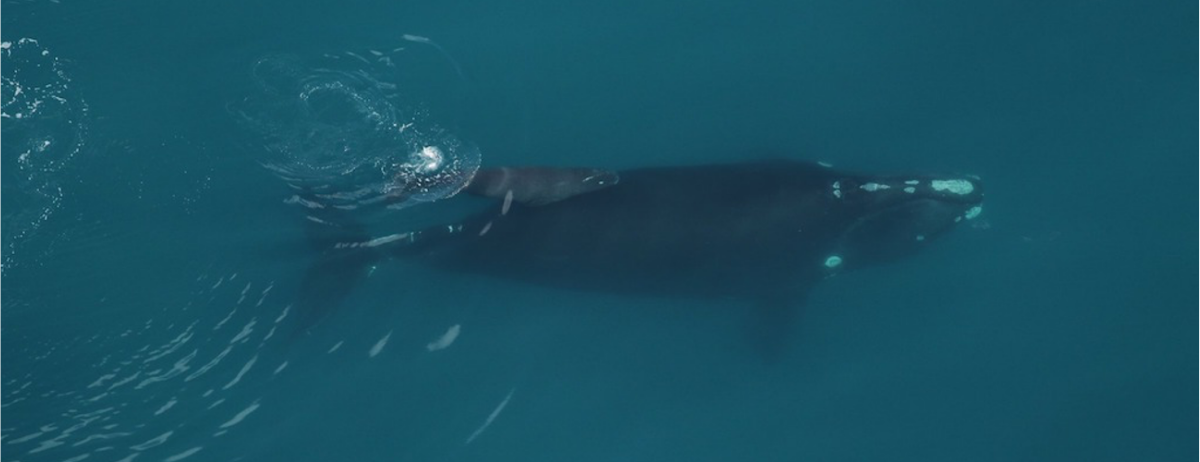
It's the saddest news
We are heartbroken to learn that the dead right whale found off New Jersey this week is actually the first born calf of the 2019/2020 season, and was the very first calf of right whale #3560.
From initial observations, it appears this calf died as a result of propeller and trauma injuries from two separate vessel strikes. According to NOAA, the first injuries were to his head and chest, and the second – and likely fatal injury – was to his tail stock.
It is unimaginable and unacceptable that a nursing calf would have even been subjected to such dangers, or to have died such a painful and violent death. At the tender age of just six months, this infant was still nursing and totally reliant upon his mother for survival.
We are re-publishing the below beautiful piece from May, written by Sierra Club Board Member and PhD candidate Julie Reimer, who shares the sights, sounds and science of monitoring critically endangered right whales. The work of people like Julie - who dedicate their professional lives to protecting these magnificent whales - is needed now more than ever before.
We must do and demand more to protect the 400 remaining right whales in our midst. They deserve better than this.

By: Julie Reimer
I can see it now: the vast blue horizon where the sky meets the ocean, the rolling waves as water ebbs and flows below, and in the distance a distinct v-shaped plume of mist. Can you see it? Can you hear it? The powerful exhale of the right whales coming home.
Tucked into the Gulf of St. Lawrence, east of the Gaspé Peninsula, the first right whales of the season are spotted. Each year from May to October, sometimes as late as December1, the North Atlantic right whale takes up residence in Canadian waters to satisfy their big appetite for copepods, tiny relatives of shrimp and their most important food source. But how do we know when the whales arrive? And how can we know where they go throughout these months? To make decisions about how we can best protect right whales from the threat of extinction, we need to know where they are and when.
By sight or by sound, right whales can be found! By sight, using observations from the water or visual surveys from the air, we can confirm whale locations. Of course, this means that people and whales have to be in the same place at the same time, and this can be a challenge. By sound, we can listen for whales under the water’s surface, covering more area with much less manpower2. Using underwater autonomous vehicles, sometimes called gliders, moored buoys, and other ocean infrastructure and technologies paired with acoustic technology and GPS, we can listen for whales in (almost) real-time and make decisions about how to protect them3.
When one of these ocean-going objects is mounted with an underwater microphone, called a hydrophone, we can listen for songs and sounds unique to right whales and other species. When the hydrophone picks up on one of these sounds, it can send that information and GPS coordinates by satellite to scientists who can confirm which species has been detected. Now, we have a way to know where whales are and when, without relying exclusively on visual observations. Since 2010, a team of researchers from across the Maritimes have been using this technology to tell us more about right whale movements and their habitats1, and to provide the science that is needed to make decisions about reducing risk to this endangered species from threats of ship strike and entanglement with fishing gear.
With climate change, ocean ecosystems are ever-changing and now more than ever we need to understand not just where right whales are going, but also why. In the past, stationary conservation measures have been put in place based on areas that were frequented by right whales. Now, right whales are visiting those places less often and our conservation strategies need to adapt to these changes1. By using this acoustic monitoring technology, scientists can understand more about the ocean environment and changes in the distribution of whales and their food. With this understanding, we can better predict places that might be frequented by right whales and act for their protection.
In the Gulf of St. Lawrence, right whales are becoming common visitors. In 2015, the average daily occurrence of right whales off Gaspé quadrupled compared to the previous three years4. While important steps have been taken to protect right whales, including new measures announced by Fisheries and Oceans Canada for this year, our work is not done. To see our goal of no deaths in 2020, we need stronger commitments to ending entanglement and fatal ship strikes. We need to ban activities that threaten the health of endangered whales, including oil and gas activities. We need to use what the science is telling us to commit to the long-term restoration of the Gulf of St. Lawrence ecosystem, to protect this species and all species - now and into the future.
Check out WhaleMap for the latest right whale observations in Canada.
Listen to right whale and other species calls here.
Watch and listen to Lacrosse, right whale #1249 here.
Sierra Club Canada Foundation Board of Directors - Atlantic Representative
. . . . .
Julie is a PhD Candidate in the Department of Geography at Memorial University of Newfoundland. Her research explores the role of marine spatial planning and management in bridging conservation and sustainability. Julie holds a Master of Marine Management from Dalhousie University and a Bachelor of Science (Honours) in biology from Queen’s University. Her research experience spans conservation social science, conservation management, and land-based aquaculture.
References
1Davies, K.T.A., Brown, M.W., Hamilton, P.K., Knowlton, A.R., Taggart, C.T., & Vanderlaan, A.S.M. (2019). Variation in North Atlantic right whale Eubalaena glacialis occurrence in the Bay of Fundy, Canada, over three decades. Endangered Species Research, 39, 159-171. https://doi.org/10.3354/esr00951
2Durette-Morin, D., Davies, K.T.A., Johnson, H.D., Brown, M.W., Moors-Murphy, H., Martin, B., & Taggart, C.T. (2019). Passive acoustic monitoring predicts daily variation in North Atlantic right whale presence and relative abundance in Roseway Basin, Canada. Marine Mammal Science, 35, 1280-1303. https://doi.org/10.1111/mms.12602
3Davis, R., Baumgartner, M., Comeau, A., Cunningham, D., Davies, K., Furlong, A., Johnson, H., . . . & Whoriskey, F. (2016). Tracking whales on the Scotian Shelf using passive acoustic monitoring on ocean gliders. OCEANS 2016 MTS/IEEE Monterey, 1-4. Monterey, CA. http://doi.org/10.1109/OCEANS.2016.7761461
4Simard, Y., Roy, N., Giard, S., & Aulanier, F. (2019). North Atlantic right whale shift to the Gulf of St. Lawrence in 2015, revealed by long-term passive acoustics. Endangered Species Research, 40, 271-284. https://doi.org/10.3354/esr01005
Sierra Club Canada Foundation National Office
PO Box 2007 STN B Ottawa ON K1P 5W3
(613) 241-4611 • 1-888-810-4204
info@sierraclub.ca

